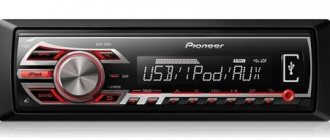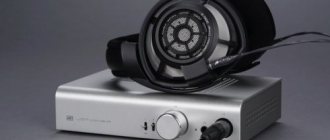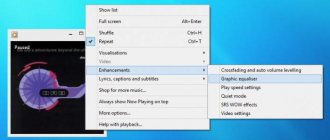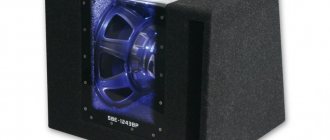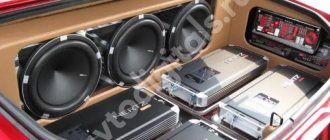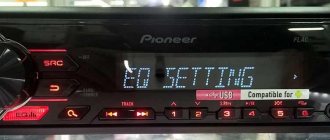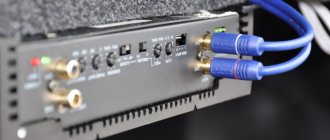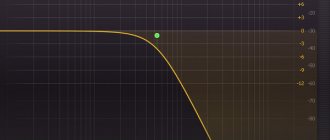Correctly selected equalizer parameters will give you realistic and rich sound when listening to music of any genre. Equalizer settings for the perfect sound involve selecting a ready-made preset and then manually adjusting it. It seems nothing complicated, but choosing the optimal values for a person without musical education and hearing is difficult, the process lasts for hours. It is important to take into account the musical genre you are adapting to, the playback characteristics of a particular device, human perception and the environment.
What is an equalizer and how to use it
An equalizer (less commonly a tone block, applicable to a device) is an application or device for selectively adjusting the amplitude of a signal depending on its frequency characteristics. To put it simply, the principle of operation of equalizers is to finely control the frequencies of an audio signal by amplifying or attenuating in certain ranges. There are amplifying, attenuating and combined (these include all modern solutions) programs and plug-ins for working with the frequency characteristics of audio signals.
Hardware equalizers are used primarily at the sound recording stage by professional recording studios. The equipment adds character to the sound, highlighting the vocalist’s voice or the sound of a particular instrument at the right moments. Software solutions are used by amateurs and music lovers already at the stage of mixing a track and giving compositions a specific sound while listening to music.
hardware equalizer
When configured correctly, the program will improve the acoustics in the sound space where the listener is located. The simplest example of using an equalizer: selecting a template that suits the musical style being listened to, and manually adjusting it to enhance (attenuate) the sound in certain frequency ranges. Namely ranges, not specific frequencies. A graphic equalizer, for example, does not regulate a single frequency (30, 125, 500 Hz), but a range around a specified frequency, for example, 30 ± 10 Hz. For high frequencies (HF) it expands to hundreds and even thousands of hertz depending on the number of bands.
Here you will have to rely more on hearing and intuition. For the sake of experimentation, it is better not to touch the sliders; the presets were created by professionals, and it is unlikely that you will be able to achieve better sound. Most likely, on the contrary, the naturalness of the composition will be lost, unless adjustments are made (lower or raise the slider a couple of positions) to suit your taste and acoustics.
Level four. Complete replacement of the standard system
There are situations when you are not satisfied not only with the sound of the standard system, but also with the functionality of the head unit itself. In this case, thoughts about replacing it become especially annoying. But this cannot always be done with small forces.
First of all, take a close look at what the standard head unit is. If it has its own display, and all audio system controls are not connected to other car systems (climate control, on-board computer, etc.), then it can most likely be safely removed, while all other systems will remain unaffected.
Don't let the original shape and size of the standard GI confuse you. Firstly, there are now many alternative head units that are produced for specific car brands and fit into the panel using the pin-to-pin principle - the seats and connectors are completely the same. Or you can use an adapter frame to install a standard 1DIN or 2DIN size device and an adapter from a standard connector to a standard ISO. They are produced by many manufacturers, so choosing the right set is usually not difficult. As a last resort, no one has canceled the custom solution either.
But if the standard “head” is combined with other car systems, then it’s more complicated. It is far from a fact that there is an alternative head unit for your car. In this case, the approach will be individual, and most likely costly.
But there is another option. It looks quite extravagant, but sometimes the only way to organize a truly high-quality audio source in a car is to leave the standard head unit unchanged and install a second one. In this case, it becomes the main one in the system, and the audio system is built from it. The standard one is shifted from the role of the main one in the system and becomes additional - its outputs are connected to the AUX inputs of the new head unit.
What are equalizer bands and what are they for?
Bands are inherent in a graphic equalizer - this is a visualization option for dividing the frequency audible to the human ear (16-20 Hz...16-20 kHz) into ranges. Each band corresponds to a specific frequency range of acoustic vibrations: 30, 250, 500 and 1, 4, 8, 16 kHz. Frequencies up to 2.4 kHz are given more attention, because the human ear is more sensitive to them, less sensitive to low ones, and high ones play an even smaller role. With age, the sensitivity of the hearing organs decreases, and the frequency range on both sides narrows.
Keep this in mind when setting up. To improve the sound, focus more on the low-end sound.
The accuracy and fineness of sound tuning depends on the number of bands (sometimes graphic equalizers are made in the form of “knobs”) of frequency ranges. In theory, using a 16-band equalizer is more appropriate than a 6-band equalizer, provided it is used skillfully, but the former is difficult to set up. It will take longer to select the optimal values for your hearing.
Car Audio Basics
If you have already decided what you want from the sound, then setting up the audio system in your car has already begun. You, as a customizer, are required to achieve the highest possible quality combination of all system elements.
Advice to all beginners - if you are starting to set up for the first time, you should not buy expensive speakers in large quantities.
For good sound, it is better to have up to three good speakers than 5-6 - the sound “at odds” will not please anyone.
What does an equalizer do?
An equalizer increases or decreases the amplitude (loudness) of acoustic vibrations in certain frequency ranges. Sound amplification below 70 Hz saturates the sound, in the range of 175-250 Hz it causes a hum, the level of which depends on the degree of amplification.
The human voice sounds at 80-250 Hz, the female voice has a higher frequency - 160-250 Hz, the male one - a lower frequency - 80-150 Hz. Take this into account if you need to emphasize the vocalist's voice or make speech intelligible during poor-quality recording or on a cheap playback device. A subwoofer is used to improve the sound of low frequencies (up to 300 Hz).
What factors affect the sound of a car radio?
Taken together, the quality, volume and clarity of the sound of car acoustics are influenced by many factors:
- The quality and power of the radio.
- Quality and power of speakers.
- The speakers are connected correctly to the radio.
- Interior sound insulation level.
- Tightness of the speaker installation location.
- On-board network voltage.
- Availability of an additional amplifier.
- The presence of a subbuffer.
- Vehicle operating mode.
- The car radio settings are correct.
Since the last point is the main topic of the article, we will return to it later. In the meantime, let’s at least briefly go over other factors that, along with the radio settings, have a direct impact on the sound of the acoustics.
It is unlikely that anyone doubts the statement that the better and more powerful the car radio, the better it will sound. Unlike budget models, which give off the characteristic smell of China, high-quality branded devices are equipped with a more powerful audio frequency amplification chip. The wiring of this microcircuit is also improved, effective cooling, filters, and so on are implemented.
The quality of the speakers is the same, so there’s no point in describing them. When selecting speakers, you should take into account their rated power and compare it with the power of the radio. At the same time, do not rush to rejoice if the box says that speakers for three kopecks can produce from three hundred to infinity watts. This is a classic marketing ploy. The speakers can and can produce such power, but only for a short time. That’s why it’s called peak. You need to select speakers based on rated power and resistance. The total power of all speakers must be no lower than the power of the radio.
By the way, the cunning Chinese also attribute watts to radio tape recorders, which cannot be there at all. Want to make sure? Carefully open the casing of the car radio and look at the model of the audio amplifier microcircuit (it is usually the largest, on the radiator, and is called the letters TDA). Enter the model into the search and see what power it is capable of at 14 volts.
A very important point is that the speakers are connected correctly to the radio. If they are connected haphazardly, it is almost useless to configure anything.
Tightness. To understand what we are talking about, we need, for example, a car with reclining rear seats, in which the rear speakers are installed in the shelf, and the rear side faces into the luggage compartment. Turn on music in such a car, and then fold down the rear seats to depressurize the trunk. The sound won't just change. It will become nothing - no bass, no volume, no depth.
And this happens because the speaker “pushes” the sound both forward and backward. And when the front space is not isolated from the back, the same sound frequencies meet and cancel each other out. Therefore, speakers should be installed so that the space behind them is as isolated as possible from the space in front of them.
The power and sound quality of a car radio directly depends on the voltage of the on-board network. If it is underestimated or sags under load, the sound will deteriorate, distortion, wheezing, clipping, and so on may appear.
An additional amplifier greatly improves the car's sound system. One well-known car blogger even once proved that it is better to buy an inexpensive amplifier on a flash drive than a not-so-cheap radio. Together they will work even better (if all other factors contribute to this).
A subbuffer allows you to enhance the sounds of low frequencies, that is, bass. However, it should be understood that for its operation you will need an additional amplifier, a low-pass filter and sufficient on-board voltage without sags.
The sound of the radio is greatly influenced by the operating mode of the car. Now we will list them in the order in which they make the sound worse and worse. The acoustics sound best when the car is stationary, with the engine turned off, the windows closed, and no people in the cabin.
Sound deteriorates due to:
- Engine running.
- Noisy tires and suspension while driving.
- Open windows.
- People in the cabin absorbing sound waves (the more passengers, the worse the sound).
If all the described factors contribute to the high-quality sound of the acoustics in the car, then all that remains is to configure the radio correctly. This is what we will do next.
Types of equalizers
Equalizers are divided into graphic and parametric. Implemented in hardware or software. Equipped with sliders to increase and decrease the volume in each frequency range. The position of the controls displays the amplitude-frequency response (AFC) of the device or application in graphical form. Depending on the field of operation, they are represented by a different number of bands: for music lovers 6-18, for professional areas - 25-31 bands per channel. The lowest and highest frequencies are represented by ceiling filters.
frequency graph
The parametric equalizer gives you even more functionality. Adjusts three parameters: operating frequency, gain or attenuation, quality factor independently of each other. The range of parameter changes reaches 1000 times (for the quality factor in some professional devices).
In digital devices, processing is carried out using mathematical methods, analogue ones introduce more changes into the sound, but the sound becomes alive and realistic.
Turning off Demo mode
Immediately after purchasing and connecting the radio, you should figure out how to disable the demo mode, intended for displaying the device in the store. It is possible to use the radio in this mode, but it is inconvenient, since when you turn it off, the backlight does not go out, and inscriptions with various information run across the display.
Disabling demo mode is very simple:
- We go to the hidden menu by turning off the radio and holding down the SRC button.
- In the menu, turn the wheel to reach the DEMO item.
- Switch demo mode from ON to OFF.
- Exit the menu using the BAND button.
You can also set the date and time in the hidden menu by going to the System section. The time display is switched here (12/24 hour mode). Then open the “Clock Settings” item and turn the wheel to set the time. In the System section there is also a language setting (English/Russian).
Thus, after purchasing a modern Pioneer model, you can easily set up the radio yourself. By correctly adjusting the audio parameters, you can achieve very high-quality sound even from a simple audio system and get a good sound picture at minimal cost.
Setting options for different types of devices
Corrective equalization is unique to each audio device and individual. You can copy other people's settings, but you will have to adapt them to suit yourself.
Optimal equalizer settings in your car for better sound
From an acoustic point of view, the car interior is a bad place to listen to high-quality music. And the problem is not only the cost of the equipment used.
- The salon is full of barriers to acoustic waves in the form of seat backs and the driver.
- The car is full of obstacles with different coefficients of absorption and reflection of acoustic waves. Moreover, the degree of absorption and reflection differs for different frequencies.
- The listener is shifted from the center of the acoustic space, located in the center of the cabin.
- Extraneous sounds penetrate into the car: the engine, noise from under the wheels and mechanical parts of the vehicle, reducing acoustic comfort.
The sound emanating from the speakers in a car depends on dozens of factors, including the material of the seat upholstery and interior, which partially absorbs and reflects acoustic waves. As a result, the bass is drowned out by low-frequency extraneous noise, high frequencies and low frequencies receive peak values due to the vibration of solid materials in the car (plastic, metal). Using an equalizer, it is necessary to “cut off” these peaks in the highs and lows, compensate for the lack of mids - make a wide frequency range audible.
The adjustment on car radios of different car manufacturers (Kia, BMW, Renault) is similar: it is performed with “twists” or up and down buttons and consists of eliminating peaks and compensating for cuts in the desired ranges. A small number of bands makes setup easier and faster. Phones are connected to car radios running Android to play music from their memory. How to set up an equalizer on Android - a couple of sections below.
Don't expect miracles from an inexpensive radio and spend hours trying to achieve crystal clear sound. Such a solution will not protect against extraneous noise. Even common Pioneer radios are equipped primarily with 5-band EQ.
Setting the equalizer for wireless headphones
Configuring an equalizer on wireless headphones with a Bluetooth interface involves building a diagram that reflects the amplitude-frequency response of the device. It is located in the technical documentation, on the official website of the equipment manufacturer, on a specialized forum.
The ideal sound is one with a flat horizontal frequency response, but it is difficult to achieve. After reflection, adjust the parameters to perfection, one by one dragging each slider down or up until the sound is satisfactory. The parameters are saved in a separate template; most applications can do this.
An approximate, and not ideal, reflection of the frequency response with its subsequent correction is sufficient.
From the following frequency response one can see the leading edge of the bass at low frequencies, a sag in the diagram at mid frequencies, an overestimation at high frequencies and a rapid drop starting from 10 kHz, becoming more significant as the frequency increases.
frequency response graph
The following scheme (using the example of the AIMP player) would be close to ideal: lowering the bass, increasing the midrange, cutting off the peaks at high frequency and a sharp increase in amplitude after 11 kHz.
AIMP player equalizer
How to properly set up the equalizer on your phone (Android and iOS)
Older smartphone models may not have an equalizer. Found in the sound settings or Google Music player. Most advanced players are equipped with their own instruments with presets to improve sound quality.
- Go to your sound settings and visit the “Equalizer” section (sometimes located under the “Sound Quality and Effects” subsection).
setting the equalizer on your phone
- Choose a suitable template and perfect the sound using manual sliders or knobs.
equalizer regulator
Most models have additional sound effects, disable them and check the sound. There are a lot of software equalizers in the Play Market: EQ Music Player, Equalizer FULL, Equalizer FX, for example, can add virtual surround sound to the sound and save profiles with settings.
The iPhone equalizer offers familiar presets without manually changing the values of the sliders. The problem is solved using third-party applications, for example, Studio Music Player, Soundly.
Setting up the equalizer on iOS
Setup on TV
Adjusting the sound on a TV is not much different from adjusting the equalizer on a mobile device or PC. The location of EQ and its functionality depend on the model and firmware of the TV. It is absent on older devices; instead, it offers sound modes such as: cinema, music, sports, voice filter and other audio signal processing technologies. The process consists of selecting a ready-made template and manually modifying it if necessary. The latter is not always available.
Setting the equalizer on your TV
To control the bass, adjust the range to 125 Hz, and with the human voice - 150-250 Hz, to give speech realism, sharpness - 620-1000 Hz, intelligible speech is made in the range - 1.2...4 kHz, 5...8 kHz - is responsible for vocal settings, adding volume to the sound. These frequencies bring other effects to the sound of musical instruments. Experiment and select.
Setting up an equalizer on a computer and laptop under Windows 7, 8 and 10
Computers and laptops reproduce sound through a variety of speakers, speakers and headphones with different sounds. Often you will have to adjust the equalizer separately for the built-in speakers, speakers, acoustics and headphones. It is advisable to save a preset for each device.
Setting up on Windows
Windows 10 has a built-in equalizer, but it is hidden from the novice user. For this reason, people resort to sound settings in audio card drivers, players, and install third-party applications.
- Open the sound settings (right click on the speaker icon in the tray).
setting sound parameters
- Call up the properties of the sound-producing device.
properties of the sound-producing device
- At the bottom, click “Additional properties...”.
additional device properties
- Visit the "Enhancements" tab and activate the equalizer.
improvement tab
- Select a preset from the drop-down list or click the three dots button to manually edit the boost and cut levels of frequencies in the graphic equalizer.
select the desired preset
- In the second case, drag the sliders and evaluate the sound; as a result, the “Save” button will be activated to write your own template to a file.
custom equalizer template
Settings in AIMP player
Let's look at the example of the classic music player AIMP v4.6.
- Expand the player window and call the “Sound Effects Manager”.
Sound effects manager in AIMP
- Activate the first option and click “Presets”.
- Select a template and apply it.
equalizer presets
- Manually drag each of the 18 sliders until you get an acceptable result.
The scale on the right is designed to change the gain level across the entire spectrum.
The finished preset is saved by clicking on the triangle next to the “Presets” button. Here the function of automatically adjusting the sound to the genre of the song being played is turned on, but the automation periodically fails.
Setting up the Realtek HD Audio driver
Most computers are equipped with a Realtek HD sound adapter. Its driver comes with a manager to control the sound. If this is not the case, download and install the latest driver from the company’s official website.
- Right-click on the Realtek HD Audio manager tray icon and select “Audio Manager”.
sound manager
- Visit the Sound Effect tab.
- Select a template from the Equalizer drop-down list. Popular ones are indicated by colorful icons under the menu.
equalizer templates
- Use the icon on the left to turn on the graphic equalizer.
enable graphic equalizer
A 10-band equalizer will appear with the familiar vertical sliders.
- Achieve the desired effect and save the configuration under a clear name.
saving configuration
The driver stores profiles adapted for listening to music in common environments: living room, living room, stone walls, felt-lined room. The manager supports up to 4 templates with sound settings, switched by clicking on the A, B, C and D buttons.
The vocal suppression function is weak and does not have a noticeable effect on the sound of the song. It will be useful when listening to lectures and seminars in low quality. Look for advanced voice suppression in AIMP in the “Sound Effects” tab.
Remember that the effects of equalizers (built-in in Windows, Realtek and the player) overlap each other. It is better to disable two of them. In this case it is an 18-band AIMP equalizer.
Possible reasons for a bad signal
You can easily figure out why the radio does not pick up the radio. Poor reception is most often caused by problems with the antenna. If the cable shield is damaged, the reception will be accompanied by severe interference. If the antenna wire breaks or breaks, or the plug that is inserted into the radio itself comes off, then the radio does not work at all. If an active antenna is used, the receiver does not pick up the radio well due to the fact that power is not connected to the amplifier, or the receiving dipoles are in poor contact with the amplifier module due to oxidation or damage.
Another reason for a poor signal is the distance of the repeater or radio tower from the receiving location and the presence of natural or artificial obstacles standing in the way of the radio channel. Noise penetrating into the radio air from the atmosphere, power lines, trolleybus and tram wires degrades the quality of reception, which is why the timbre on some radios is floating and an unpleasant hiss appears, which hurts the ear. Devices made in Japan have poor radio reception due to their range, which differs from that used in Russia.
On cheap Chinese radios, radio interference can occur from various electronic devices, for example, DVRs. Another reason why the radio in the car does not work is a malfunction of the tuner itself. You should also check the speakers, malfunctions of which cause wheezing and crackling noises that make tuning difficult.
Manual settings and equalizer presets for different sounds
Both sound card drivers and players store ready-made presets adapted for listening to music of certain genres. It is recommended to use them, first adapting them to your needs (different spectral sensitivity of the hearing organs, playback devices, music lover preferences, etc.). The above describes how to work with templates, edit them to suit your needs, and save them.
To boost the bass, you can boost frequencies up to 250 Hz manually or select the appropriate “Full Bass” or “Bass” setting in AIMP and the Realtek HD driver. In other players, the item has a similar name. Also try "Full Bass & Treble".
setting for bass boost
Surround Sound
Realtek HD Manager provides a virtual surround sound option in the Speaker Configuration tab.
virtual surround sound
A similar option is built into Windows – Windows Sonic. To activate, call the context menu of the speaker tray icon, move the cursor to the “Spatial Sound (Disable)” item and select “Windows Sonic for Headphones”. With acoustics support, the “Dolby Atmos for headphones” option will appear in the list.
enable spatial audio
An alternative way to solve the problem.
- Open sound options.
sound parameters
- Click “Device Properties” after selecting the playback device.
device properties
- Select the spatial audio format and close the window.
select spatial audio format
Sometimes you need to restart the player or restart the game to activate the settings.
Features and differences depending on the manufacturer
Correct setting of the car radio is necessary so that a clear and loud melody is heard from the speakers, the speakers do not distort the sound and no additional noise is heard.
All Pioneer DEH and other 3100 and above models are configurable by changing the position of the joystick. The handle of this part of the device can rotate in all directions and go deeper into the body. This device helps you set up car radios from most companies, use the menu and find the necessary parameters in it.
Setting up the standard radio can be done in other ways. For example, in the Japanese device Clarion CP435L1 there is a hidden menu, which is called up by simultaneously pressing button 6 and turning Tune 10 clicks with the ignition on.
Setting the parameters of each model is prescribed in the instructions, which also describe the device of the radio and the functions of the various buttons.
